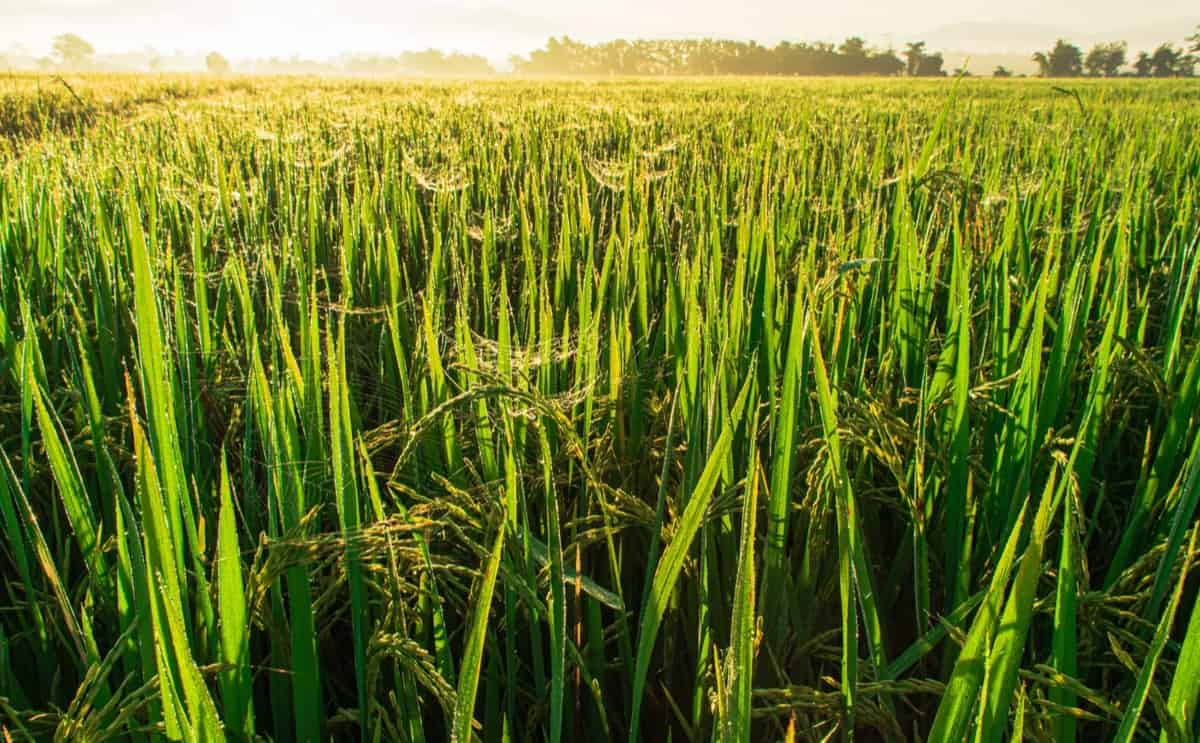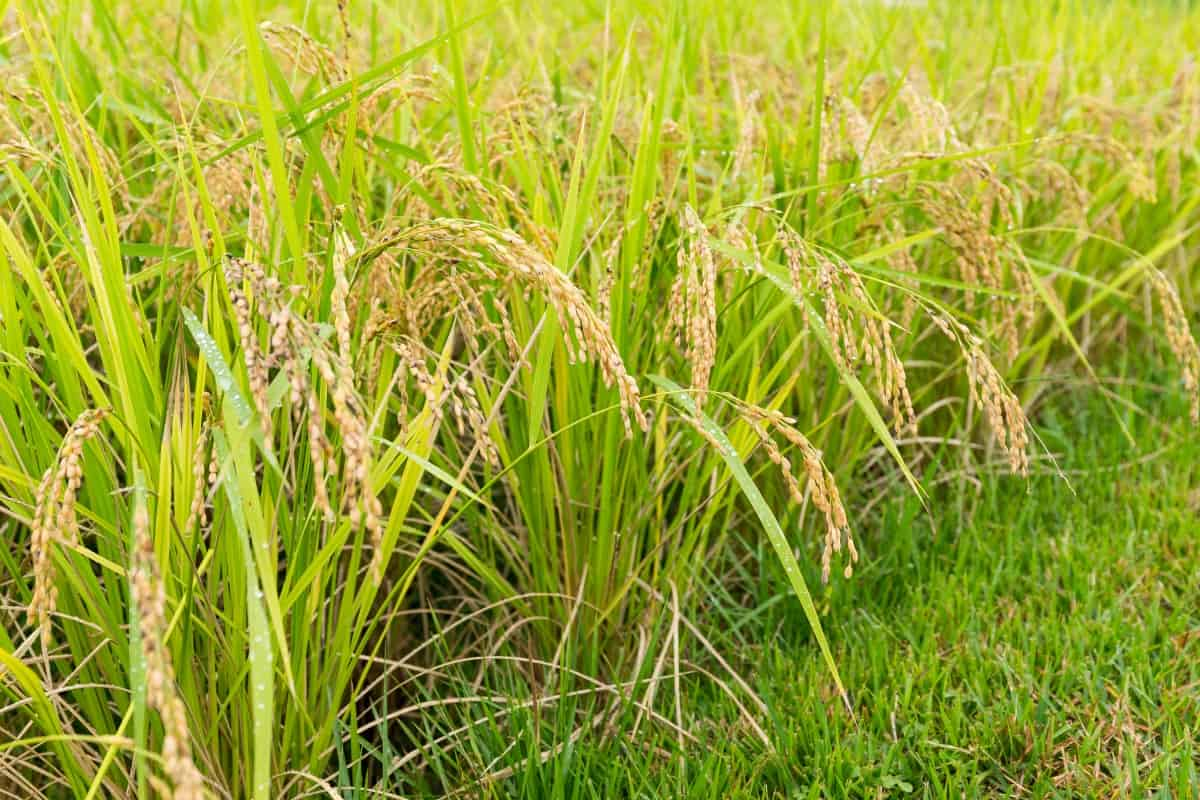The Tungro rice disease is a major danger to global rice production. It is caused by two viruses spread by leafhoppers, the Rice tungro bacilliform virus (RTBV) and the Rice tungro spherical virus (RTSV). The principal vector for disease transmission is the green leafhopper. Tungro disease affects rice crops at all stages of growth, but it happens most often when the plants are still green. When the two viruses work together, they change the color of the leaves, slow growth, reduce the number of tillers, and make the grain less.

The disease has the potential to affect crop production and grain quality drastically. Tungro infects not just cultivated Rice but also some wild rice and other grassy weeds in rice paddies, making it a perennial nuisance for rice growers. Plants infected have yellow or dead spots on their leaves, which can cause them to die and wilt completely. The disease can reduce grain output by remaining partly or empty.
Rice Tungro disease management in Paddy
The causal organism of Rice Tungro disease
- Rice tungro disease is caused by two viruses, Rice tungro bacilliform virus (RTBV) and Rice tungro spherical virus (RTSV). It is transmitted by leafhoppers, particularly the green leafhopper.
- Leafhoppers can acquire the viruses from infected plants by feeding on them quickly and immediately transmitting them to other plants within 5-7 days.
- The rapid spread of the disease through the rice crop can result in widespread infection and significant crop losses.
- To manage Tungro disease, farmers must control the population of leafhoppers and prevent the spread of the viruses through insecticides or by promoting the growth of natural predators.
Favorable conditions for the spread of Rice Tungro disease
- The presence of viral hosts.
- The vector is present.
- Host plant age and susceptibility.
- Synchronization of the mentioned three elements.
- All stages of rice plant growth, particularly the vegetative stage
- Tungro infection can develop at any stage of the rice plant’s growth. It is particularly common during the vegetative period. Plants are particularly susceptible when they are tillering.
Symptoms of Rice Tungro disease in Paddy
- Tungro causes stunting and reduced tillering in plants.
- The leaves become yellow or orange-yellow and may have rust-colored markings.
- Yellowing begins at the tip of the leaf and may progress to the bottom portion of the leaf blade. The third leaf from the top of the most affected plants is taller than the others.
- Young leaves are frequently sprinkled with pale green to yellowish interveinal stripes. In contrast, older leaves may have rusty streaks of varying diameters.
- Flowering is delayed, and the panicles are tiny and need to be fully developed.
- The majority of panicles have infertile or partly loaded grains.
- If the plants become infected too soon, they may die.
- Tungro virus illness impacts all phases of rice plant growth, with a focus on the vegetative stage.
Percentage of yield loss due to Rice Tungro disease in Paddy crop
- Rice in South and Southeast Asia is susceptible to a disease known as tungro, which is the most damaging disease of Rice. In extreme circumstances, sensitive Tungro cultivars that were infected at an early development stage might suffer a yield loss of up to 100 percent.
- As soon as tungro is present in the field, its incidence in young rice plants begins to overgrow. The young rice plants are the plants that leafhopper vectors like to feed on the most. They can also acquire tungro viruses from younger plants that are already infected with them.
In case you missed it: Stem Borer Management in Paddy: Symptoms, Treatment, Chemical, Biological, Natural, and Organic Control

Detection of Rice Tungro disease
- Plants infected with tungro can be recognized chemically using the iodine test.
- At six in the morning, take samples of the leaves.
- The top 10 centimeters of the leaf are submerged in a solution consisting of either 2 grams of iodine and 6 grams of potassium iodide in 100 milliliters of water for 15 minutes or 10 milliliters of tincture of iodine combined with 140 milliliters of water for an hour.
- Either of these processes can be repeated three times. Detection was achieved by washing in water.
- Leaves infected with tungro have a dark blue streaking pattern.
- New Technology: Serological techniques such as the Latex agglutination test, Enzyme-Linked Immunosorbent Assays (ELISA), and Rapid Immunofilter Paper Assays can be used to confirm Rice tungro disease (RIPA).
Rice Tungro disease management in Paddy by cultural methods
- Plant-resistant varieties are available that are resistant to Tungro disease.
- Adjust the planting date.
- Observe a fallow period of at least a month to eliminate hosts, viruses, and vectors of the disease.
- Rotate with pulses or oil seeds in epidemic areas.
- Apply neem cake as a basal dose in the nursery.
- Plough and harrow the field after harvest to destroy stubbles.
- Eradicate other Tungro hosts.
- Destroy weed hosts on bunds.
Rice Tungro disease management in Paddy by biological methods
The rice tungro virus causes rice crop disease. Nephotettix spp. Insects spread the virus to Rice. P. fluorescens can manage this disease. This biocontrol agent targets Nephotettix spp., the vector, to prevent viral transmission and Tungro in rice harvests. Farmers may avoid Tungro infestations and safeguard their rice harvests with biocontrol.
Rice Tungro disease management in Paddy by chemical methods
- To minimize leaf yellowing, 2% urea mixed with Mancozeb at 2.5 gm/lit can be sprayed, or foliar fertilizer like multi-K (potassium nitrate) can be used at 1%
- Green leafhoppers, the vectors of tungro disease, should be effectively controlled in time by insecticide spray.
- Vegetation on the bunds should also be sprayed with insecticides.
- When virus infection is low in the nursery, apply Carbofuran granules at 1 kg/ha to control the vector population.
- When one affected hill is observed, apply Carbofuran granules from pre-tillering to mid-tillering at 3.5 kg/ha.
- Two rounds of insecticides such as Thiamethoxam 25 WDG 100g/ha or Imidacloprid 17.8 SL 100ml/ha should be applied 15 and 30 days after transplanting.
In case you missed it: Rice Brown Spot Management in Paddy: Symptoms, Treatment, Chemical, Biological, Natural, and Organic Control

Rice Tungro disease management in Paddy by natural/organic methods
Light traps can control the spread of tungro by attracting and killing leafhopper vectors. In the morning, the population of leafhoppers near the light trap should be sprayed/dusted with insecticides daily.
Conclusion
Effective management of Rice Tungro Disease in paddy involves understanding symptoms and using chemical, biological, natural, and organic treatments and controls. Effective control measures include using biocontrol agents and implementing sustainable practices to prevent outbreaks.
- Deworming Schedule for Dogs/Puppies: A Beginners Guide
- How to Prevent and Control Parasites in Goats
- Beneficial Insects in Pest Management
- Natural Solutions for Pest Control in Flower Gardens
- Types of Fungicides Used in Agriculture
- Common Issues in the Fruit Development Stage of Pomegranate Farming
- Fruit Development Issues in Papaya: Easy Solutions and Treatment
- Soil-Borne Diseases and How to Protect Your Plants
- Practices to Prevent Disease Spread in the Garden